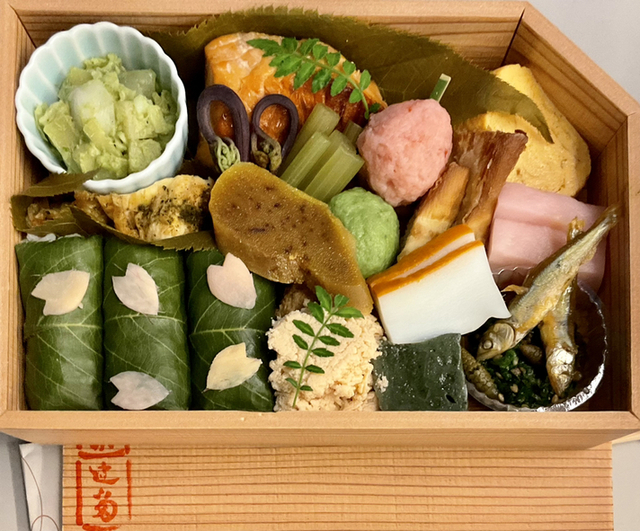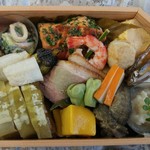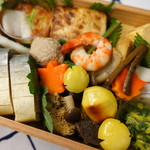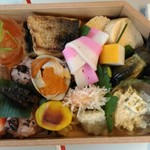
辻留 京都伊勢丹店
Tsujitome ◆ つじとめ
3.54
Kyoto Station Area
「Bento (Lunch Box)」
5,000-5,999円
5,000-5,999円
Opening hours: 10:00-20:00
Rest time: Same as Isetan Kyoto Store Business hours and holidays are subject to change, so please check with the store before visiting.
京都府京都市下京区烏丸通塩小路下る東塩小路町901 ジェイアール京都伊勢丹 B2F
Photos
(20)




















Details
Reservation Info
can be reserved
Payment Method
Credit cards accepted
Electronic Money Accepted
Private Dining Rooms
None
Smoking and Non-Smoking
No smoking at the table
Parking
Yes
Shared with Isetan parking lot
Comments
(20)
fd1ee5
4.50
We ended our luxurious Kyoto trip with a bento box from Tsujitome. I made a reservation in advance from Tokyo, but had to be careful about the days they offer it. For example, they don't have bento boxes on certain days like at Wakuden. Of course, the expiration date is 8:00 on that day, and pick-up is around 7:30 at Isetan basement. It was a tight space on the Shinkansen. The person next to me was typing on their laptop. Sorry. But there's no store here, and it's not the one in Akasaka, so please forgive me. It was spring, and there were cherry blossom petals scattered around. The bites were small, so I savored each one slowly. I can't believe a bento box can be this good! Oh, amazing.

abx155
4.00
I purchased a bento box from the traditional and famous bento corner at the B2F floor of Kyoto Isetan to eat on the way back on the Shinkansen. I bought one bento each from the traditional stores Tsujitome and Wakuden to compare and taste. Tsujitome is a specialty catering store in Kyoto, established in 1902 with its main store located in Higashiyama Sanjo. I made a reservation over the phone a few days ago. I arrived at Kyoto Isetan in Kyoto Station building around 3:30 PM. Despite the crowded place, I received the bento boxes at the traditional and famous bento corner on the B2F floor. It is recommended to make a reservation to ensure you get one as they were sold out when I arrived. The Tsujitome bento (5400 yen) was opened on the Shinkansen train. The size is not too big, measuring 13.5×19×5cm per tier. The bento box came with a Tsujitome hand towel, allowing you to immerse in the Tsujitome world while enjoying the bento on the train seat tray. The box is made of wood, giving a luxurious feel, with "Gion" written on the top, which is cute. Upon opening, the bento box was filled with sparkling Kyoto dishes. The contents of the Tsujitome bento include bamboo shoots and lily root with wood buds, dashimaki tamago (rolled omelet), shrimp soboro (minced shrimp), warabi (bracken fern) simmered in broth, yuba (tofu skin) grilled with sansho pepper, karasumi (bottarga), Wakayama’s specialty dish of young ayu fish simmered with wood buds, shrimp ball, matcha dumpling, and chicken ball on a bamboo skewer, lotus root simmered in renkon (lotus root) and sesame, bamboo shoots simmered with wood buds, bamboo shoots simmered and deep-fried, golden grilled squid, trout grilled with yuzu-flavored miso and wood buds, and sea bream sushi roll with cherry blossom leaf. The bento box was filled with a variety of mountain vegetables such as bamboo shoots and warabi, typical of spring Kyoto cuisine. After tasting, I must say that everything was delicious. The Tsujitome bento exceeded my expectations. The delicate flavors enhanced the taste of the ingredients, showcasing the essence of Kyoto cuisine, which focuses on the ultimate dashi (broth) dishes. The cooking technique to make it taste best when cold, as well as the quality of the ingredients, were remarkable. Particularly delicious items included the grilled trout with yuzu-flavored miso, which sealed the umami of the trout, and the yuba grilled with sansho pepper, which had a fragrant Kyoto yuba flavor. Comparing it with the two-tier bento from Wakuden that I also ate, Tsujitome had a more refined and delicate flavor, typical of Kyoto cuisine, while Wakuden had slightly stronger and sweeter flavors. A clear comparison can be made by tasting the dashimaki tamago, which uses a lot of dashi in Kyoto. Both bentos were truly wonderful and it was difficult to determine which was better, but on that day, I slightly preferred the Tsujitome bento. Although it may seem a bit expensive at over 5000 yen, it is definitely worth the price. Thank you for the meal.




かるねつばら
4.20
Tsujidome bento, sold at the department store underground at Kyoto Station and on the JR Shinkansen premises. The "Yoshiautumn Bento" costs 5,400 yen including tax. It is quite popular, so I had trouble purchasing it in the past. However, this time I happened to come across it by chance. I immediately bought it and headed to Kyoto Imperial Palace to enjoy it on a bench. The contents of the bento are as follows:
- Mackerel sushi
- Rolled omelette with dashi
- Striped horse mackerel with miso
- Sea bream with salted radish and grated daikon
- Three-leaf wood ear steamed
- Nimiki southern barbarian pickle
- Chestnut sweet simmered
- Grilled eye blue bamboo skewer (shrimp, cucumber, shiitake simmered)
- Shrimp simmered
- Sweet potato simmered
- Black bean salt-boiled
- Ayu simmered
- Yuba fried simmered
- Shichimi grilled chrysanthemum leaves
- Chrysanthemum flower sesame soaked
- Kiss-style dried sake grilled
- Fiddlehead fern simmered
- Ginger sweet vinegar pickled
When you open the lid, the box is packed full of food, with each item carefully arranged. There are about seven different types of fish dishes, along with vegetables such as potatoes, edamame (a nice palate cleanser), yuba, rolled omelette, mackerel sushi, and chestnut sweet simmered (saved as dessert and enjoyed last). The overall seasoning is rich in dashi, with a subtle sweetness from mirin and sugar. The high-quality dishes are on par with those served in traditional Japanese restaurants. The variety of fish dishes in this bento enhances the luxurious feel. Each dish is prepared differently, allowing for a delightful and varied eating experience. The sliced "ayu" has plenty of eggs and is delicious with the rich dashi flavor. The "striped horse mackerel with miso" is a large slice and very satisfying. The "chrysanthemum leaves and flowers with sesame" and "sea bream with salted radish and grated daikon" are served in small dishes, each delicately seasoned and of high quality, reminiscent of dining in a restaurant. The "yuba fried simmered with shichimi" was exquisite. The yuba, rolled into a circle, is deep-fried and lightly dusted with shichimi, creating a fragrant and flavorful dish. With each bite, the umami flavor gradually unfolds, offering a deep and unique taste, characteristic of Kyoto cuisine. Though the price is high, it is justified by the quality of ingredients and cooking techniques. Unlike other bentos, it is not overly sweet, allowing the flavors of each ingredient to shine through. The compact bento box is filled with premium flavors and contents, resembling a treasure chest. It gives the impression of dining at a traditional Japanese restaurant. I look forward to enjoying it leisurely with sake in a room on my next visit.



玉かずら
3.50
Autumn was like this. It seems like mackerel sushi is common in any season. Burdock is like pine, shimeji is like mushrooms, konjac is like leaves of a tree. The simulated garden appears in a small wooden box, and it's so beautiful. I think the overall taste and everything is like Hishiyama, but I like this too.


粉山椒
3.00
I ordered this famous bento box online and had it at home, assuming that I have been living in Kansai for about 70 years. The taste was very strong for me. Despite the reputation for being light in flavor, it was not the case. Maybe it's because it's a bento box. The light flavors were in dishes like "grilled miso-marinated mackerel," "rolled omelette," and "ginkgo nuts, fiddleheads," which were quite light. They had interesting flavors that were different from the usual. I'm not sure what the right answer is. The other dishes like "wood ear mushroom steamed with grated radish and trefoil, simmered taro, fried chicken, quail simmered with autumn leaves, simmered red leaf wheat gluten, simmered burdock, simmered shimeji mushrooms, simmered konjac, chrysanthemum greens and flowers with sesame dressing" were strong in taste. The simmered dishes in particular were very strong. It was too much for me since I would be eating it on the same day, so I didn't feel like buying it again.

3298S
3.30
The rating on Tabelog is still high at 3.65 (as of 2021.01.16). It seems to have been buried in drafts for quite some time. The saltiness was a bit of a concern, but that's just how it is. It's been a while since I last had it, but I still feel that 5000 yen excluding tax is quite expensive. It may not be as good as Hyotei, but Tsujitome seems to be trading on its name. Tsujitome, which is criticized by chefs who know its true nature from the past, seems to be appreciated by food enthusiasts for its connections to Urasenke. It's not widely known that Urasenke tried to switch from Tsujitome to other restaurants (such as Kikunoi), but were repeatedly turned down and had no choice but to stick with Tsujitome.

ガレットブルトンヌ
4.00
On the way back from Kyoto, I had reserved this bento box to enjoy on the Shinkansen, but ended up having it at home due to lack of time. It cost 5,400 yen (tax included) and came wrapped in beautiful Kyoto scenic wrapping paper, with chopsticks and a hand towel. The bento was filled with a variety of meticulously prepared dishes, making me feel the arrival of spring. It included: sea bream sushi rolls with cherry blossom leaves, rolled omelette with dashi broth, grilled salmon with wood sorrel, minced shrimp with yam, simmered yuba with butterbur, shrimp skewers, matcha rice cake skewers, chicken meatball skewers, bamboo shoot and wood sorrel salad, simmered bracken fern, squid, simmered gluten with mugwort, simmered sea bream roe, simmered squid, grilled mini eggplant, and pickled ginger petals. It was a box full of spring flavors, showcasing the artistry of Japanese cuisine.


タケマシュラン
2.50
"Tsuji-ryu Bento" is a high-end bento box that costs 5,400 yen, the most expensive in my life by far. My first impression was that it looked small. I questioned whether it was really worth 5,400 yen. The packaging had labels like "calcium hydroxide" and "coloring," which seemed a bit off-putting. When I tasted it, it was delicious, especially the rolled omelette had a unique flavor. However, other items like mackerel sushi were good but not significantly different from cheaper options. It felt more like a premium class airplane meal rather than a 5,400 yen bento. I wish it was priced closer to 2,000 yen.



肥の国夜郎
3.50
I decided to leave Kyoto in the morning. It was a bit early for lunch, so I bought a bento box to eat on the Shinkansen. I chose "Tsujitome" because I had heard of its name before and wanted to try it. It cost 5400 yen. The bento box came with a cloth napkin, giving it a luxurious feel. I opened the lid while on the train and admired the beautiful presentation. I started with the mackerel sushi. The bento box also included various dishes like rolled omelette, grilled mackerel with miso, simmered sea bream with grated daikon, fried chicken, grilled saury, simmered chestnuts, and more. It was packed with a variety of flavors. Overall, it was a unique experience, although I'm not sure if it was worth the price.


diemberⅡ
3.00
I happened to purchase a bento box from Tsujitome at Isetan in Kyoto Station. In short, the seasoning was too strong, making me crave water while eating the bento. The use of high-quality sea urchin without bitterness was impressive. The ingredients used were appropriate for a bento box in the 5000 yen range. However, even the dashimaki tamago had an overly strong seasoning. The tai sushi was also too salty for my taste. In Kyoto, where you can have a decent lunch at a relatively well-established restaurant for 5000 yen, I couldn't see the necessity of trying this bento box. I think that the bentos from Wakuden, which are more reasonably priced and have better seasoning, might be a better choice. I think this may have been just a one-off experience, so I would like to try it again in a different season.
yana946
3.20

頑張れ自分
3.50

頑張れ自分
0.00

changenchan
3.30
It's certainly delicious, but not worth 5400 yen. I would say it's worth paying 3500 yen.
とみのぞ
3.80
Kaiseki bento box @ 5,400 yen
kぐらむ
3.00
I have used the bento corner at Isetan several times. The Tsujitome bento is priced at 5400 yen, which is the highest price range in this corner. However, I found that bento from Gion Nishikawa or Wakuden in the same price range are more delicious and have more volume. The Tsujitome bento seems to be slightly salty in flavor. My wife, who prefers sweeter flavors, got tired of the salty taste halfway through. While I do think it is delicious enough, I feel that Isetan offers other delicious options. The fact that it comes with a hand towel is a nice touch, which may appeal to those who want it.



チャッピーチャンス
3.70
This time, I entered "Tsujitome" at the Kyoto Isetan department store basement 2nd floor, which is a long-established bento shop. Established during the Meiji era and located in Higashiyama Sanjo in Kyoto, this shop specializes in catering and is also a purveyor to the Urasenke school of tea ceremony. Their seasonal limited edition bento can be purchased at Kyoto Isetan, and there is only one type available, the "Seasonal Assorted Bento". The wrapping paper depicting Kyoto's townscape is exciting in itself, but when you open it, you will find an original Tsujitome hand towel inside. This kind of thoughtful gesture is probably why they have been loved for so long. The characters written on the hand towel are from the renowned gourmet and artist Rosanjin Kitaoji. When you lift the lid, you will see a variety of colorful seasonal dishes, such as sea bream sushi with a hint of kelp, grilled trout with yuzu fragrance, and simmered conger eel and edamame. These dishes, representing the first catch of the season, the peak of the season, and the remnants of the season, are packed tightly and go well with sake. I bought it as a souvenir when my father was traveling and I was alone at my mother's hometown. Luckily, there were two left, and I was able to purchase them in time for the evening. The delicate seasoning may not be satisfying for those unfamiliar with Kyoto's flavors, and the price of 5400 yen may seem high for a bento. However, if you think of it as being able to enjoy a mini kaiseki meal at home, it may be worth it. If you are curious, why not stop by and try it out?




玉かずら
3.50
I picked up a special menu commemorating the 20th anniversary of Kyoto Isetan, which cost 5400 yen. It included dishes like small sea bream sushi, rolled omelette, grilled trout with miso, seared bonito with wild garlic, shrimp mince steamed in sake, sea bream with grated daikon and green onion, shrimp and taro tempura, boiled white fish with salt, yuba with sansho pepper, karasumi (bottarga), warabi fern with pickled vegetables, fuki tempura, chrysanthemum greens with sesame dressing, skewered shrimp, cucumber, and konjac with seaweed, seaweed and wheat gluten simmered in soy sauce, duck breast tataki with simmered vegetables, and sweet pickled ginger. It was a delicious meal.


連続お食事件
4.30
I heard from an acquaintance that the bento from Tsujitome is amazing, so I wanted to buy it on this trip. Unfortunately, when I went to a certain department store basement, it was sold out!! The staff said, "It always sells out quickly. It's safer to make a reservation." Oh no! So, I left the store and was about to board the Shinkansen when I saw a souvenir shop inside the ticket gate. I thought I would just buy some mackerel sushi from "Izu" as usual, but to my surprise, they were selling the Tsujitome bento!! What a fateful encounter, just like in a drama! The Tsujitome bento was priced at 5400 yen. Expensive, but I didn't hesitate to buy it. When I opened it at home, it came with a Tsujitome hand towel. Not that I didn't want it, but it added to the luxury. Opening the lid, it looked stunning and artistic. The main dish was teriyaki yellowtail, red snapper sushi, steamed abalone topped with sea urchin, tender chicken meatballs with rare texture of karasumi. Everything was delicious above average. I must say, this was the best bento I have ever eaten. If you go to Kyoto, be sure to buy this amazing bento to take home!




さむそいぽ
3.50
When sightseeing in Kyoto, one of the highlights is enjoying a bento box on the return Shinkansen ride. I decided to try the Tsujidome bento this time, which I pre-ordered from the longstanding bento shop at the JR Kyoto Isetan department store basement floor. The "Respect for the Elderly Day Bento" cost 5,400 yen including tax. The contents included red rice with black sesame seeds, grilled conger eel and shrimp sushi rolls, grilled clams with sea urchin and scallops, grilled yellowtail with miso, rolled omelette with dashi, salmon roe with grated daikon radish and mitsuba, fish cake skewer, marinated conger eel, simmered chestnuts, grilled squid skewers, cucumber skewers, and konnyaku skewers, simmered ayu fish with roe, deep-fried glass noodles with shrimp, deep-fried sandfish with miso, grilled mini eggplants, simmered yuba with grated yuzu, pickled ginger in sweet vinegar, and pickled vegetables. Overall, the flavors were relatively mild. The simmered ayu fish with roe stood out as particularly delicious with its bold flavor. There were also some elaborately prepared dishes that looked visually appealing.


Email Login